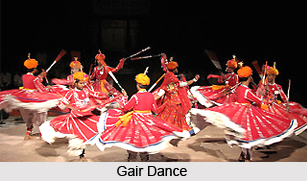 Dance forms of Jalore district are varied in their nature and performance styles. There are many different dance forms prevalent in the district, performed on occasions and festivities. While some dances are performed by males, others are performed by both men and women. Also while some dances are performed for marriage functions and other festivities, others are performed specifically during or after Holi. Thus the dances differ in range of performance. The point of similarity between the different dances would be that most of them are performed to the tune of beat drums and plates, and are accompanied by folk music typical to the style of performance. The various dance forms of Jalore district are discussed below.
Dance forms of Jalore district are varied in their nature and performance styles. There are many different dance forms prevalent in the district, performed on occasions and festivities. While some dances are performed by males, others are performed by both men and women. Also while some dances are performed for marriage functions and other festivities, others are performed specifically during or after Holi. Thus the dances differ in range of performance. The point of similarity between the different dances would be that most of them are performed to the tune of beat drums and plates, and are accompanied by folk music typical to the style of performance. The various dance forms of Jalore district are discussed below.
Dhol Dance
This dance is performed on the occasion of marriage by the Malis, Dholis, Sargaras and people of Bhil communities. Sargaras and Dholis are professional folk singers and drum beaters who are very proficient in this art. Dhol is predominantly a male dance, where 4 to 5 drums are beaten consecutively. When the dance commences, the leaders beat their drums in `Thakna Shaili`. As soon as Thakna ends some dancers put swords in their mouth, some have lathis and others take a handkerchief in their hands, and thus the dance starts. It this dance common people can also take part with professionals.
Dandiya Dance
A group of 20-25 males with long sticks in their hands, move around in a sequential pattern in this dance form. The dancers beat their sticks and dance parallel to each other. The dancers wear fancy dresses depicting Kings, traditional Moneylenders (Sahukaars) Saint Shivaji, Lord Rama and Sita and acts like them. This dance starts after the festival of Holi and continues for many days. When the dance is being performed, Shehnai players, Nagada beaters and singers sit in the middle of the stage. The male singers sing the lengthy songs called folk loris. Also, Dhamal and dance oriented Holi songs are sung. In these songs there are praises of Bhairuji of Badli most of the times. Gair dance, Girad and Dandiya dance have many similarities, but they differ in terms of leg work, facial expressions, rhythm, songs and attire.
Gair Dance
This dance is also mainly performed by the males. The dancers dance around with long sticks. In it, many males dancing together form different groups. Drums, Baakiya and Plate (Thaali) are used for playing music, with the musicians performing in the midst of the dancers. Folk songs influenced by `Shringar Ras` and `Bhakti Ras` are also used in this dance. Dancers wear white clothes from shoulder to waist, and a leather belt is tied. In the belt, there is also a place for keeping a sword and frills are tied on to the turban. The facial expression of dancers expressing divine expressions is enough to attract anyone. The dancers are called Gairiya. This dance starts the day after Holi and lasts for 15 days. All the people of the area take part in the dance, like Malis, Purohits, Choudharys, Rajpurs, Meghwals etc. Many Gair dancers of district have earned national andInternational fame. Some Gair dancers have also had the opportunity to show their art in the Republic day function held in Delhi.
Loor Dance
This dance starts month before Holi and ends with Holika`s destruction. It is a female dance. After concluding their work at home in the evening they converge in an open or any other convenient place and the performances are held. As many women can take part in the circle, a huge circle is made while dancing. The dance is also conducted community wise by women in their streets, but in the general space reserved for Loor in the village, any community member can take part. Women of all ages and unmarried women can also take part.
Shakur Dance
This dance signifies the hunting of the wild pig, accompanied by the beating of drum plates and small round bells. It is dance of rural background. Bijaram, a resident of Bijli village has given it a national identity with performances at Lok Utsava Ajmer, Lok Utsav Delhi and North area Cultural Centre Patiala. He has also performed at Chandigarh, Sikkim, and Siliguri.
Matki Dance
This dance form is all about dancers carrying filled pots on their uncovered heads and dancing to the rhythm of drums and plates.
Chang Dance
Though Chang dance is performed in all of Rajasthan, it acquires a distinct character in Jalore accompanied by folk songs. There are many people from different castes who sing to the performance of Chang.
Thus discussed are the many different styles of dance performances in the district of Jalore.



















